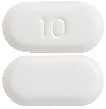1. Why am I using APO-EZETIMIBE?
APO-EZETIMIBE contains the active ingredient ezetimibe. Apo-ezetimibe is used to lower cholesterol levels.
For more information, see Section 1. Why am I using APO-EZETIMIBE? in the full CMI.
2. What should I know before I use APO-EZETIMIBE?
Do not use if you have ever had an allergic reaction to ezetimibe, or any of the ingredients listed at the end of the CMI.
Talk to your doctor if you have any other medical conditions, take any other medicines, or are pregnant or plan to become pregnant or are breastfeeding.
For more information, see Section 2. What should I know before I use APO-EZETIMIBE? in the full CMI.
3. What if I am taking other medicines?
Some medicines may interfere with APO-EZETIMIBE and affect how it works.
A list of these medicines is in Section 3. What if I am taking other medicines? in the full CMI.
4. How do I use APO-EZETIMIBE?
- The recommended dose is 10 mg taken once a day, at any time of the day
- Take tablets with a glass of water
More instructions can be found in Section 4. How do I use APO-EZETIMIBE? in the full CMI.
5. What should I know while using APO-EZETIMIBE?
| Things you should do |
|
| Things you should not do |
|
| Driving or using machines |
|
| Drinking alcohol |
|
| Looking after your medicine |
|
For more information, see Section 5. What should I know while using APO-EZETIMIBE? in the full CMI.
6. Are there any side effects?
Common side effects: nausea, diarrhoea, wind or excessive gas, indigestion, heartburn, decrease appetite, dry mouth, abdominal pain, constipation, inflammation of pancreas, dizziness, headache, tingling/ numbness of the hands or feet, gallstones, inflammation of gallbladder, elevation of some laboratory blood tests, unusual tiredness, muscle spasms, pain in neck/ chest/ arm/ legs/ or back, hot flushes, high blood pressure, swelling of hands or feet, depression, cough.
For more information, including what to do if you have any side effects, see Section 6. Are there any side effects? in the full CMI.

